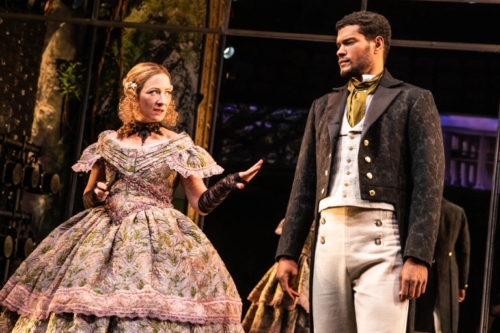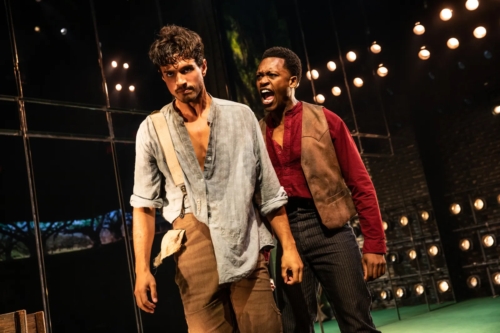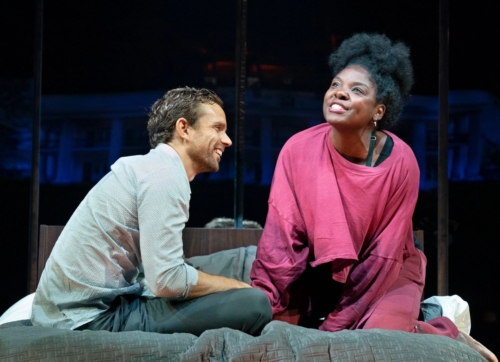“You should not work to make the audience comfortable with what they are witnessing at all.”
Notes on style, Pg.4
Slave Play by Jeremy O Harris is a 2018 three act stage play. Three modern interracial couples (two straight, one gay) attend a retreat to work out the issues in their relationships via slavery-based roleplay. This reveals and strains various faultlines in their relationships and their psyches.
I should make it clear that I have not seen a production of Slave Play, and what follows is based purely on reading the script. Also, for the record, I’m a white, heterosexual cis male.
It’s a cliche that well-meaning white liberals say “I don’t see color.” This denial makes interracial cuckoldry or raceplay so scandalous, because “seeing color”, both your own and others’, is essential to the experience. Of course, it’s also where people-of-color get stuffed into a limited set of one-dimensional stereotypes.
The characters add their own nuances to their roles in the raceplay scenes.
The play opens with Kaneisha (black straight female) as an Antebellum slave, sweeping out a cabin. Rihanna’s song “Work” suddenly starts playing from nowhere, and she twerks to this, just as Jim (white straight male) enters, as the overseer, whip in hand.
Jim stammers before he can say “negress”, and goes out of his way to distance himself (and/or his character) from the real slaveholders.
JIM
I don’t own ya.
That’s
Ya know
That’s
Master MacGregor.
Up in the big house.
MASTER.
MacGregor.
I’s just…
Kaneisha negotiates the scene on the fly.
KANEISHA
Mista Jim?
Is that better?
JIM
Mista Jim’s alright.
KANEISHA
Ok…
Mista Jim.
Kaneisha, for her part, coaxes Jim towards her preferred actions in the scenario.
KANEISHA
Oh!
Well…
I mean…
If I was you
I don’t think–
I don’t think
I’d wanna beat myself, Mista Jim.
That,
To me,
That aint something I’d wanna do.
But I aintchu sir.
In another part of the plantation, Alana (white straight female) plays an overheated southern belle who wants her “boy” Phillip (“mulatto” straight male) to play a “negro spiritual” on his fiddle, though he’d rather play Beethoven.
ALANA
So play something that’ll make me hoot and holla like the negresses outside waiting to run on ya later.
He actually plays Ginuwine’s bachelorette party classic “Pony”, which has the desired effect on Alana. She strips down to lingerie and throws herself at him.
ALANA
I want to be inside you!
Ain’t that queer?
This culminates in Alana taking out a huge black dildo and penetrating Philip, while rhapsodizing about the sexual failures of white men, the pleasures of white women with black men, and the ensuing mixed babies and lynched black men.
ALANA
You like this?
PHILLIP
I’m not sure, Mistress.
The third dyad is Gary (black gay male) as an enslaved overseer dominating an indentured servant, Dustin (white gay male).
GARY
Watcha ow’ing about
Dustin?!
That should feel normal for ya.
Shouldn’t it?
Seeing how you aint nothing but a white man
Waiting for a good dusting
Of MY BOOT!
Here the dominance and submission is more ambiguous, and that tension is eroticized. It’s Gary who has an emotional reaction, falls down and weeps, leaving Dustin at a loss.
In Jim and Kaneisha’s area, she repeatedly urges him to call her racist names. Jim is the one who literally calls the safeword “Starbucks” and halts all of the scenarios.
This leads into Act 2, when the couples and the facilitators Teá and Patricia, a POC lesbian couple, meet for group discussion. This is all a couples retreat to process the anhedonia in their relationships, the inability to feel pleasure.
TEÁ
I think it’s really important to reiterate
That
What we all just explored
Was incredibly difficult
And triggering,
But it was also fantasy.
Right?
[…]
Therapy.
This is what you’re seeing:
Antebellum Sexual Performance Therapy.
A RADICAL therapy designed to help black partners reengage intimately with white partners from whom they no longer receive sexual pleasure.
It starts to look like, beneath the therapy-speak, Teá and Patricia are searching for landmines by poking random things with sticks, not really considering the consequences. All six of the participants are raw and exposed after their interrupted scenes.
Jim goes out of his way again to disavow feeling any sexual arousal in the scene, saying “you made me” and “she made me”. This may be the kind of deflection common in fantasies, of imagining some outside force “making” the fantasizer do something taboo.
Philip says that the female-dominant scenario he just played out with Alana is “not that different from dynamics we’ve had in the bedroom.” Alana denies this as absurd. Philip brings up that they met via FetLife, as part of a cuckold scenario involving her husband. Alana does her own disavowal, saying “That had NOTHING to do with race” and shifting the blame onto her husband.
ALANA
It wasn’t racial.
I swear it wasn’t.
KANEISHA
Maybe not for you.
The two white heterosexuals, Jim and Alana, both are aroused by their raceplay scenes, and both engage in complex disavowals and deflections to avoid confronting that. Even temporarily suspending the taboo of racialize sex seems to bring out the worst in them, while their partners (Kaneisha and Philip) are aroused because their partners finally “see” them as black. The same principle applies with Gary and Dustin.
Kaneisha is largely silent through this act, until she calls Jim a “virus”: “Your mere presence was biological warfare.” His whiteness is as unthinking, as pervasive and as lethal as a virus.
Act 3 is Kaneisha and Jim talking alone as she packs to leave. It’s mostly Kaneisha’s monolog about her childhood visiting plantations in the South and her relationship with Jim, including when things went wrong.
KANEISHA
…when I told my friends
They said,
“That happens. That’s every couple
Just give it a few eeks.
A few months. DON’T CHEAT.
Just take some time…
Or see if he’s into being open?
Are either of you tied to monogamy?
Maybe invite someone in?
Are you into women?
Have you tried choking?
A little rape play?
How are you spicing things up?
Fantasy is important.”
The breaching of the raceplay taboo in her own mind simultaneously revealed that she doesn’t love Jim, and, paradoxically, aroused her because this is a moment of clarity, of heightened reality.
KANEISHA
Because, baby,
I realized,
The elders watching me.
They are watching me lay in bed
Every night with a demon
Who thinks he’s a saint.
And the elders don’t care that you
Are a demon,
They lay with them too….
They just want you to know it.
And me to know it.
So I can lie with grace.
So I can lie with their blessing
Slave Play solves the problem of raceplay, at least for POCs. When she’s playing a “negress”, she’s not really submitting to him, she’s communing with her ancestors. This is a way of viewing raceplay for POCs as not submitting to the historical racial hierarchy, but connecting to a racial experience.
Problem is, Jim tries to solve a very complex emotional/historical problem with sex, initiating a raceplay scene with her without warning. Kaneisha safewords before it gets too far, and thankfully Jim complies.
Slave Play isn’t exactly pro-raceplay. The scenes create spaces where the usual inhibitors and fail safes on the couples’ relationships are removed, and the once repressed forces explode. It’s likely that all three of these couples are over after this. It could be seen as what happens if you do raceplay, or any other taboo play, without negotiation beforehand.
One notable absence is the lack of a lesbian couple doing raceplay. Teá and Patricia, described in the text as “a mulatto” and “a light brown woman”, respectively, are a couple and this experiment is said to be based on interactions in their own relationship, but we don’t get a scene of them together. Maybe Harris decided he couldn’t relate to a lesbian relationship, or that he could only fit so much in a two-hour play, or that lesbians wouldn’t have their own raceplay dynamic. Slave Play’s matrix of race, gender, sexuality and role is already pretty complicated.








[…] Review: Slave Play, by Jeremy O Harris […]
[…] Review: Slave Play, by Jeremy O Harris […]
[…] Review: Slave Play, by Jeremy O Harris […]
[…] Review: Slave Play, by Jeremy O Harris […]
[…] Review: Slave Play, by Jeremy O Harris […]
[…] Review: Slave Play, by Jeremy O Harris […]
[…] Review: Slave Play, by Jeremy O Harris […]
[…] Movie. A Play. is a 2024 documentary about the production and reception of Jeremy O. Harris’ Slave Play. Currently streaming on HBO and […]